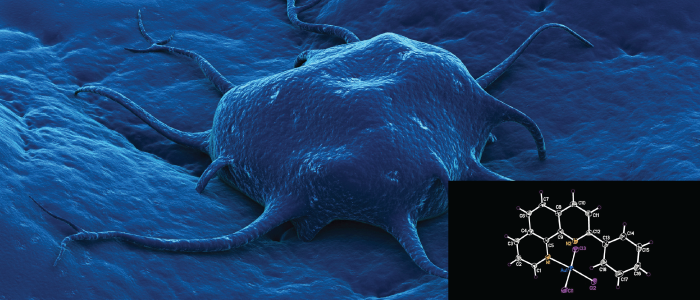Above: The research group investigated the structure and anti-tumor behavior of an inorganic compound against colon cancer cell lines. Here, the molecular structure shows the atomic labeling scheme and 50 percent probability displacement ellipsoids.
In 1978, the Food and Drug Administration approved cisplatin, a platinum-based compound, for clinical use. Cisplatin today is widely recognized as an effective cancer-treating drug, but it also is known to cause many severe side effects, such as kidney damage, nervous system impairment, nausea and vomiting. Thus, there is a strong interest in developing similar, new drugs that are less toxic.
“Numerous studies are focusing on the development of other metal complexes – those containing metal centers such as ruthenium, copper and rhenium – with potential application as biological sensors and/or drugs for photodynamic therapy for cancer,” said Sibrina Collins, Ph.D., assistant professor of Inorganic Chemistry at the College of Wooster.
As part of a recent study, Collins’ research group used Ohio Supercomputer Center resources to help investigate the structure and anti-tumor behavior of an inorganic compound, namely [Au(pnp)Cl3] (pnp = 2-phenyl-1,10-phenanthroline), against colon cancer cell lines.
“At the College of Wooster, the Senior Independent Study requirement allows our chemistry majors to make important intellectual contributions to faculty research,” Collins said. “Thus, training students is an important component of my research efforts.”
The objective of the research in the Collins Group is to develop a detailed understanding of the molecular structures, electronic structures, photophysics and reactivity of a selection of late transition metal complexes and exploit this understanding to design effective anticancer agents.
Recently, Collins and her colleagues investigated the structure of several late transition metal complexes containing gold(III), copper(II) and palladium(II) containing the pnp organic ligand. They found that the gold complex adopted a monodentate bonding motif, where only one atom in the ligand binds to the metal and the molecular planes produced angles similar to other trichloridogold(III) complexes noted in scientific literature.
Project Lead: Sibrina Collins, Ph.D., College of Wooster
Research Title: In-house and synchrotron X-ray diffraction studies of 2-phenyl-1,10- phenanthroline, protonated salts, complexes with gold(III) and copper(II), and an orthometallation product with palladium(II)
Funding Source: College of Wooster, Elizabeth Ralston Presidential Endowment for Faculty Development Award, William H. Wilson Research Fund, and Henry Luce II Fund for Distinguished Scholarship
Website: http://www.wooster.edu/bios/scollins/

